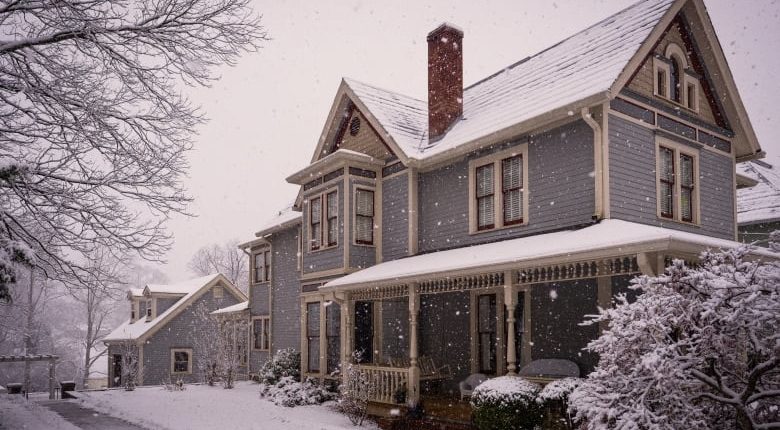The Old Farmer’s Almanac Canadian winter forecast never gets a warm reception, especially if last year’s winter was any indication. But this year’s forecast has both good and bad news.
The good news, according to Managing Editor Jack Burnett is: “This winter will be not-quite-so-cold in almost all of Canada.”Only southern B.C. will see colder-than-normal temperatures. The bad news? It’s going to snow, a lot. Burnett says “It’s going to be snowier throughout the whole country, from Yellowknife to Halifax. The exceptions are areas of southern B.C., southern Alberta and central/western Quebec, which will still be wetter than normal with sleet and freezing rain.” In fact, Burnett is expecting “8-11 major snow events”, which they’re referring to as “game of snows”, dubbing the upcoming winter a “polar coaster”.
A deeper dive into their science raises questions, but whether it’s going to extra snowy or extra cold, we want to know how to prepare. We talked to a mechanic about a pre-winter vehicle prep checklist. Then we reached out to both a home and a garden expert to take us through a list of the most important things to consider for each, which we’ve listed here.
Preparing your home for winter
Doing an annual, pre-winter check up can do a lot for your home both in the short and long term. To get the specifics, Damon Bennett, Professional Contractor and Construction Consultant, told us what to look out for. Bennett likens inspecting your home before winter to an airplane before take off — you need to make sure everything is tight, sealed and in working order.
Doors
“A great way to winterize your doors is with weather stripping,” says Bennett, “it can go a long way to stopping drafts. If you already have weather stripping installed, check it every fall and spring for wearing and gaps, and replace if needed.”
Bennett also suggests you check the caulking around your doors, “Caulking shrinks and gaps can be created that would allow heat to escape and cold to get in. Caulking can also be used to fill any gaps in and around your door frame.” Another tip Burnett offers to keep the cold out, especially if you don’t have a storm door, would be to “add a draft guard between the bottom of the door and the threshold.”
Windows
Similarly to your doors, Bennett advises you should inspect the caulking of your windows to fill any gaps you find.” He also says, “Look for condensation between the panes of thermal windows.This means the seal has been compromised and the gas has escaped.”
Garage Doors
If you hear unusual sounds — like squeaking, squealing, grinding, a struggling motor, or if your garage door just sounds off, Bennett says “it’s time to investigate”.
“Keep everything lubricated,” he says, “rubber seals between door panels, seals along the bottom of the door and around the frame and all moving metal parts (hinges, cables, springs, rollers, etc.).” Bennett also cautions to make sure the bottom of your door is parallel to the ground and to check that your garage door opens and closes smoothly and isn’t lurching or hesitating at any point.
Pipes
“Remember to turn off your outdoor taps before it freezes,” says Bennett. “Make sure you don’t have any pipes near exterior walls or exposed without insulation, underneath porches or in crawl spaces.”
Everything else
Also on Bennet’s checklist is a chimney inspection, restructure or cleaning, if necessary.
He also counsels to check your eavestroughs for gaps between the house and the troughs, and to clean them to prevent ice damming. Make sure your downspouts are pointing away from the house and that all water will drain away from the foundation (with properly-graded landscaping).
Check your attic insulation for gaps, top up and fill them with bags of insulation.
Check dryer vents for blockages, nests and anything else that could prevent exhaust.
Check your roof for missing shingles and flashing.
Burnett also suggests that you inspect your outdoor walking surfaces, steps and porch. “Secure your railings, fix any chips,” says Burnett, “If you have a bricked curve or paved area starting to crack, when water gets in and freezes, it’s going to be a major job next winter.”
“The benefits of maintaining really come back to reward you”, Burnett says, “There’s a great deal of improvement in doing this once, but even more than that every year. Every year, there will be less and less to do, and your home gets better and better.”
Preparing your garden for winter
Your spring prep really starts in the fall. “As soon as New Year’s Day comes, people get excited,” Burnett says, “Only to realize they didn’t clear the grounds, clean tools, drain the birdbaths and rain barrels, and prepare everything before winter.” The time is now to get your lawns and gardens ready, so you can fully enjoy them in the spring. We reached out to Jon Peter, Curator and Plant Records Manager for the Royal Botanical Gardens, to help use with some pressing plant-prep questions.
How are perennials affected by winter?
It all depends on which perennial. “Every species is different,” says Peter, “Some perennials will prefer the extreme cold, while others will dislike and even succumb to difficult winters. There are many factors that go into this for each species.” Herbaceous perennials have a different system than woody plants (which are also considered perennials), coniferous and evergreen species, and a host of others. Broadly speaking, even though soil doesn’t get as cold as the air, Peter says, “The roots are more likely to suffer damage than above ground parts of the plants. The plants with the greatest tolerance of extreme cold are the ones which are best able to moderate the water held within the tissue cells. It is when the water in the tissues begins to freeze that there can be issues.”
He suggests researching the hardiness of each species and which Canadian zones are good for them via the Government’s hardiness site. “Generally, native species will be perfectly adapted to the winter extremes,” Peter says, “If growing non-natives, then try to ensure you are buying locally grown plants, which would be acclimated to your regions conditions. A locally produced native maple or baneberry will tolerate winter better than the same maple or baneberry grown at a nursery in North Carolina.”
Are there plants that are particularly sensitive to a harsh winter?
“Yes, there are certain morphological and cultural characteristics which make some species more sensitive to harsh winter conditions,” says Peter. “If a perennial is evergreen or semi-evergreen, if a plant has a shallow root system, if it has succulent stems and/or leaves, or if it retains living tissue in above ground portions of the plant through winter, it may have a more difficult time getting through the depths of cold winters.” Peter lists exposed areas, too dry/wet soil, fertilizer, freeze-thaw, road salts, temperature fluctuations and time to acclimate to conditions as critical factors. “Don’t fertilize plants in late summer or fall,” he warns, “as this will stimulate growth, which will not have a chance to harden off before winter strikes, and will likely result in dead branch tips.”
Are the plants we planted this year more sensitive?
Again, it’ll depend on species and a host of other factors, but this is generally true. “Newly planted plants have not had as long to establish a solid root system,” says Peter. “Most plants will go through a period of transplant shock, where they grow less and may get stressed.” Peter notes that this shock could last one-to-two growing seasons for herbaceous perennials, but larger trees can experience it for many years. To minimize it, Peter says, “You should try to promote soil health and limit the stresses for these new plants, which will in turn help them to sustain tough winters.”
How will the bulbs we planted handle the cold?
“Most of the bulbs available in Canada will be perfectly hardy in our climates,” says Peter, “The crucial factors here are proper planting depths and timing. Bulbs like tulips and daffodils will grow roots upon planting in the fall and before freeze-up, so you need to give them that chance.” Peter also warns that planting bulbs in poorly draining soils may lead to rots and disease. As a general rule of thumb Peter says, “Plant bulbs 2-3 times the height of the bulb, so a 2″ bulb would should be planted with the top of the bulb sitting 4-6″ below ground level.”
Should we wrap our evergreens in winter?
Whether it’s to reduce exposure to winter wind and sun, prevent splitting from snow and ice loads or to protect your plants from rodents and deer, wrapping may help, but it can only do so much. “There are more efficient ways to minimize rodent and deer damage,” says Peter, “If snow load splitting is a concern, then tie up your specimens with twine or be diligent of brushing off ice and snow during these events. To ensure your evergreens don’t suffer from winter burn, water them well leading up to ground freeze. Only wrap plants which are newly planted or potentially stressed plants for the first winter.”
How else can we prepare our gardens for the winter?
In order to provide the healthiest growing conditions for your plants year round, regardless of the season, Pete suggests the following:
A healthy plant will take on winter without flinching. Ensure you have adequate moisture in the soil before the ground freezes up.
Don’t cut back most herbaceous perennials, as this will help to protect against exposure, soil erosion and will assist in holding the snow cover in place providing a blanket of cold protection to the soil and the important roots within. Some herbaceous perennials like hostas, which can go flat and mushy with the onset of a hard autumn frost, can be cut back in fall.
Make sure next years “eyes” are not overly exposed by covering with a thin layer of soil/mulch for protection.
Likewise, cut back any plants with known disease infections, as this will help to reduce the disease re-infecting the following year.
Rarely should you exceed a mulch layer of more than 2-3″ around your plants through all seasons.
If you are an adventurous gardener and are trying to overwinter some marginally hardy species, an extra compost/mulch layer, or some conifer boughs layered on top of the soil might help to get those tender gems through the extremes.
Tips to ensure a blooming spring
“The end of winter is the best time to prune many trees and shrubs (not spring-flowering shrubs, like forsythia, which bloom on previous years growth), as this is the best time to prune for shape and structure,” Peter says, noting it’s also “the best time to recognize issues like dead and diseased and the time when you are least likely to transmit disease/insect issues via your pruning tools, as the majority of pests will also be dormant at this time.”
It’s also the right time to cut back herbaceous perennials, too. “I prefer to cut them back in shorter pieces and leave the cut up debris to lie in the garden to act as a mulch for the coming season,” says Peter. “Also, take into consideration the beneficial insects that might be overwintering (as eggs, caterpillars or adults) in the hollow stems of these herbaceous perennials, and leave those loosely piled in the corner of the garden, so that the beneficial insects can continue to complete their life cycles.”
Source: https://bit.ly/2J5W7Hm





Recent Comments